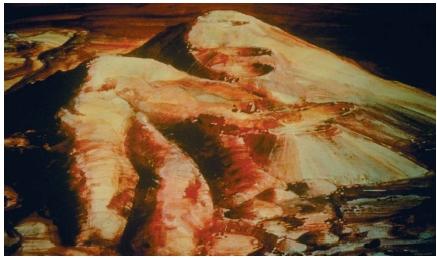Venus
Venus, the second planet from the Sun, is the closest planet to Earth. It is visible in the sky either three hours after sunset or three hours before sunrise, depending on the season. This pattern prompted early astronomers to refer to the planet as the "evening star" or the "morning star." Venus is named for the Roman goddess of love and beauty. Throughout history, the planet has been thought of as one of the most beautiful objects in the sky.
Venus and Earth have long been considered sister planets. The reason for this comparison is that they are similar in size, mass, and age. The diameter of Venus at its equator is about 7,500 miles (12,000 kilometers). The planet revolves around the Sun at an average distance of 67 million miles (107 million kilometers). It takes Venus about 225 Earth days to complete one revolution. The planet spins extremely slowly on its axis, taking about 243 Earth days to complete one rotation. Like Uranus and Pluto, Venus spins on its axis in the opposite direction to which it orbits the Sun.
Space probes to Venus
Beginning in 1961, both the United States and the former Soviet Union began sending space probes to explore Venus. The probes revealed that Venus is an extremely hot, dry planet, with no signs of life. Its atmosphere is made primarily of carbon dioxide with some nitrogen and trace amounts of water vapor, acids, and heavy metals. Its clouds are laced with sulfur dioxide.
Venus provides a perfect example of the greenhouse effect. Heat from the Sun penetrates the planet's atmosphere and reaches the surface. The heat is then prevented from escaping back into space by atmospheric carbon dioxide (similar to heat in a greenhouse). The result is that Venus has a surface temperature of 900°F (482°C), even hotter than that of Mercury, the closet planet to the Sun.

Under Venus's atmosphere, the U.S. and Soviet space probes found a rocky surface covered with volcanoes (some still active), volcanic features (such as lava plains), channels (like dry riverbeds), mountains, and medium- and large-sized craters.
Magellan . The U.S. probe Magellan mapped the entire Venusian surface from 1990 to 1994. The Magellan radar data showed that Venus is remarkably flat, and that some 80 percent of the planet's surface is covered by smooth volcanic plains, the result of many lava outflows. Magellan also revealed the existence of two large continent-like features on Venus. These features are known as Ishtar Terra (named after the Babylonian goddess of love) and Aphrodite Terra (named after the Greek goddess of love). Ishtar Terra, which measures some 620 miles (1,000 kilometers) by 930 miles (1,500 kilometers), lies in Venus's northern hemisphere. It has the form of a high plateau ringed with mountains. The largest mountain in the region, Maxwell Montes, rises to a height of 7 miles (11 kilometers). Aphrodite Terra is situated just to the south of the Venusian equator and is some 10,000 miles (16,000 kilometers) long by 1,200 miles (2,000 kilometers) wide. It is a region dominated by mountainous highlands and several large volcanoes.
Astronomers analyzing Magellan 's data have concluded that about 500 to 800 million years ago, lava surfaced and covered the entire planet,

giving it a fresh, new face. One indication of this event is the presence of volcanic craters and other formations on the surface that lack the same weathered appearance of that of older formations.
[ See also Solar system ]
Comment about this article, ask questions, or add new information about this topic: